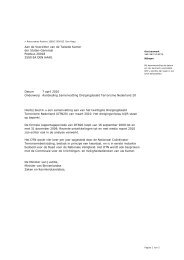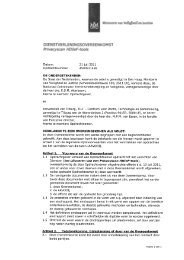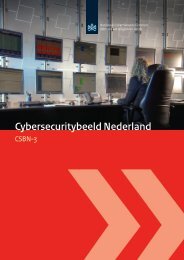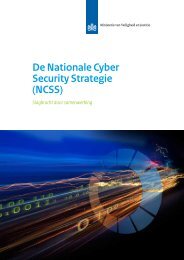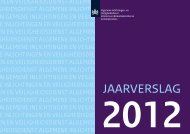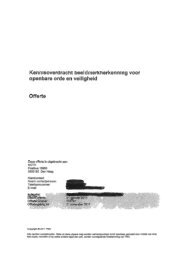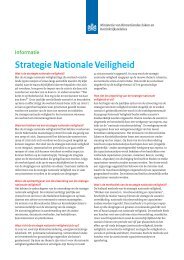third Cyber Security Assessment Netherlands - NCSC
third Cyber Security Assessment Netherlands - NCSC
third Cyber Security Assessment Netherlands - NCSC
You also want an ePaper? Increase the reach of your titles
YUMPU automatically turns print PDFs into web optimized ePapers that Google loves.
get the script kiddies started. One example is the SQL injection tool<br />
Havij that can be used to call up databases on insufficiently secure<br />
websites with just a couple of mouse clicks. [41]<br />
Humannet example<br />
In April 2012, a report by the television programme Zembla<br />
revealed that security of the internet application Humannet<br />
that is used by absence management companies to process<br />
customer, medical and absenteeism data, was not effective.<br />
Behind the scenes, the application still offered access to an<br />
old log-in page that did not have the latest security patches.<br />
It seemed that the application was relatively easy to hack into<br />
using SQL injection. As a result, the details of 300,000 patients<br />
were compromised. The fact that the application was run and<br />
the data stored by an external company does not exempt the<br />
employer and owner, in this case the absence management<br />
companies, from the responsibility of ensuring data security.<br />
3.1.3 Increase in the volume of unique malware<br />
There has been a sharp increase in the number of incidences of<br />
unique malware in recent years. The AV-TEST Institute records more<br />
than 200,000 new instances every day. [42] This sustained increase is<br />
presumably the result of lots of (automatically generated) versions<br />
of the same type of malware and the morphing (reshaping) of<br />
malware. As a result, analysing and recognising malware signatures<br />
has become technically impossible. Several anti-virus solutions are<br />
therefore looking at common ways in which malware behaves to<br />
aid detection.<br />
3.1.4 <strong>Security</strong> solution attacks bypass security<br />
An alternative approach is to refer to a list of reliable software<br />
(‘white-listing’) as a tool. If software (in which case it is assumed to<br />
be malware) does not appear on the list, it should not be installed.<br />
However it was noticed at the beginning of 2013 that malicious<br />
parties were temporarily able to contaminate the white list provided<br />
by the software security company Bit9 because they had gained illegal<br />
access to a facility where they could digitally certify software samples<br />
as bona fide. [43] Some of their customers were still able to recognise<br />
these samples as malware thanks to other anti-virus solutions.<br />
41 http://www.troyhunt.com/2012/10/hacking-is-childs-play-sql-injection.html<br />
42 www.AVtest.org, data collated on 14 May 2013<br />
43 http://krebsonsecurity.com/2013/02/security-firm-bit9-hacked-used-to-spread-malware/<br />
44 https://www.security.nl/artikel/45214/1/Nederlands_politievirus_dreigt_met_niet_<br />
bestaande_wet.html,<br />
https://www.security.nl/artikel/45117/1/Nederlands_politievirus_krijgt_makeover_%2Aupdate%2A.html<br />
45 http://malwarealert.org/trojanandroidginmaster-a/<br />
46 https://www.botnets.fr/index.php/Citadel_ZeuS_bot<br />
3.1.5 Ransomware<br />
Ransomware is not a new phenomenon, but last year users also<br />
received extortion demands for alleged offences such as computer<br />
criminality, genuine or fictitious visits to pornography sites and<br />
child pornography. Using crude forms of pressure such as displaying<br />
police logos, and child pornography together with the user (via<br />
their webcam), intensified the impact on the victims. Even more so<br />
than hacking, skimming and fraud involving internet banking, this<br />
had a direct impact on individual citizens’ sense of security.<br />
Ransomware hijacks the infected system’s functionality, for example<br />
by encrypting files or blocking the operating system from working.<br />
The malware demands a payment from the user to restore the<br />
blocked functionality and generally puts the user under pressure<br />
not to report it. The criminals use encryption and virtual digital<br />
money so that they can remain beneath the radar. There are now<br />
various updated versions of ‘police ransomware’ targeted<br />
specifically at the <strong>Netherlands</strong> (Reveton and Urausy) [44] that lock<br />
computers in saying this has been done by the police.<br />
3.1.6 Mobile malware<br />
The increased threat to mobile platforms continues. Android is<br />
the main target. [46: Sophos 2012] The most common forms of attack are<br />
scams, spam and phishing. [1: Blue Coat 2013] While the methods are still<br />
relatively simple, they are clearly profitable. Users are tempted into<br />
installing fake anti-virus and fake apps (for example Angry Birds<br />
Space or Instagram). These apps install malware on the device or<br />
send unwanted and unauthorised SMS messages to premium rate<br />
numbers. [50: TM 2013] Gaining unrestricted access rights to the data on<br />
a mobile device is something else malware aims to do (for example<br />
GinMaster [45] ).<br />
Furthermore, just as last year there are also various variants of<br />
malware directed at financial services: Zitmo, Spitmo, the mobile<br />
variants of ZeuS and SpyEye. These focus on a broad range of<br />
information, including incoming SMS messages, passwords and<br />
contact details. Although these forms of attack are on the rise, the<br />
volume of malware directed at mobile platforms is currently still<br />
just a fraction of the malware directed at standard computers.<br />
3.1.7 Botnets<br />
Botnets are networks of collaborating devices, generally private<br />
or business computers that are known as ‘bots’ and are infected<br />
with the same malware. Criminals can control a botnet centrally<br />
to use the computing capacity for their own purposes. Botnets are<br />
frequently used to send spam and to carry out DDoS attacks.<br />
The malware landscape used to create botnets is currently dominated<br />
by a number of malware families. The most familiar is the<br />
ZeuS family. One group derived from this [46] yet still separate are the<br />
botnets based on Citadel malware, such as Pobelka and Plitfi.<br />
The Citadel botnets enjoyed media attention in the <strong>Netherlands</strong><br />
following on from incidents surrounding Dorifel and Pobelka.<br />
Botnets are known for being used by criminals to manipulate<br />
financial transactions. However the Pobelka botnet demonstrated<br />
28



